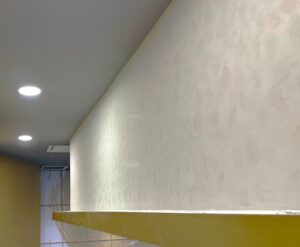
Spray painting is a dynamic and flexible way of applying paint. It is very good at producing smooth and even finishes. It is, therefore, a favorite for many DIY fans and professionals. The main advantage of spray texture paint is the fact that it makes the coating even, and the mode of application is also efficient, being able to penetrate unreachable areas. From enamel and lacquer to acrylics, these differ enormously in characteristics and the area of use.
What is Spray Painting?
Spray painting is the technique in which paint gets applied via an atomizing device, dispersing paint in droplet form. That way, spray paint provides surfaces with both coats of paint evenly distributed and is suitable for several projects.
Benefits of Spray Painting
The method shines in several areas:
- It ensures a smooth and even coat, often unachievable with traditional brushes or rollers.
- The efficiency of the application means projects are completed faster, saving time.
- Its capability to access hard-to-reach spots ensures comprehensive coverage.

texture coating
Types of Spray Paint
Understanding the types of spray texture paint helps in selecting the right one for your project:
- Enamel Paints are durable and suited for outdoor furniture and appliances.
- Lacquer Paints dry quickly and are perfect for projects needing a high-gloss finish.
- Acrylic Paints are versatile, water-based options great for a variety of surfaces.
Choosing the Right Spray Paint for Your Project
It can never be overstated that the choice of spray paint is one of the most important to the success of your job. Think about the material and surface that needs to be worked on, but equally important: the finish you want—gloss, matte, or satin?
In addition, think about whether your project is outdoors or indoors since that will determine the durability of the paint. Brand and quality also contribute, whereby you would wish to be guided by the most reputable companies in that line to be sure of the best outcome.
Factors to Consider When Selecting Spray Paint
When choosing spray texture paint, assess these aspects carefully:
- The project surface and material influence the paint type. Some paints adhere better to certain materials.
- The variation of paint changes, with the kind of finish that is preferred. The shiny finish of the paint greatly changes the look and its application, as with the matt finish.
- Indoor vs. outdoor use: Outdoor projects require paints formulated to withstand the elements.
- Brand and quality: High-quality paints from reputable brands often yield better, more reliable results.
Essential Spray Painting Equipment for Beginners and Professionals
Spray painting needs more than just a can of paint. It needs correct gear that will ensure smooth application and professional results.
Spray Paint Canisters
If you feel that you are ready to handle spray texture paint, always remember that it is available in canisters. One can try even the smallest project without any additional tools. Identifying the types of canisters will help adjust the approach to spray paint.
Spray Guns
For larger projects or a more refined finish, spray guns become essential. They come in two main types:
- Gravity-Feed Spray Gun situates the paint above the nozzle, using gravity to assist in the paint flow. Great for more detailed work.
- Pressure-feed spray Guns use compressed air to feed paint through the gun, ideal for larger, more uniform applications.
Safety Gear
Always ensure that you are safe. Always wear gloves, at least, masks and respirators to prevent fumes and particles from getting into contact. Wear at least eye protection and you are good to go.
Preparing Your Workspace
Before applying, lay drop clothes or tarps to cover the area around. This makes for easier cleaning up and prevents accidental over-spraying.
Preparing Your Surface for Spray Painting to Ensure the Best Results
Preparing your surface correctly is the key to getting the best finish with spray texture paint. And that begins long before you press the nozzle. Here’s how to get off on the right foot.
Cleaning the Surface
Make sure the surface is clean: any dust, grease, or residue may make the paint not stick properly. Use a mild cleaner; it can simply be made at home. The item should be well wiped afterward with a piece of soft cloth. Allow it to dry completely before moving to the next step.
Applying Primer
A primer would provide a smooth paintable surface that would further increase paint adhesion and permanency. Use a rust-inhibitive primer on metal. For plastic and other non-porous surfaces, look for a primer specifically intended for the material to be painted. Coat evenly with primer and allow to dry as the manufacturer advises.
Sanding and Smoothing the Surface
Lightly sand the primed surface with fine sandpaper. This is done to scuff the surface, not to remove the primer. This is however necessary to give texture to your paint for gripping. Then make sure all surfaces are well dusted afterwards with a clean, dry cloth to provide a smooth base to work over.
Spray Painting Techniques for a Flawless Finish
With your surface prepped, you’re ready to paint. Here, technique matters as much as the quality of your paint.
Proper Spray Can Technique
Hold the can approximately 6 to 8 inches from the surface. Start spraying just before the object and continue beyond it to avoid drips and get even coverage. Many thin coats should be applied rather than one thick one, allowing drying in between.
Spray Gun Techniques
If a spray gun is used, make settings that ensure they meet the requirements of the type of paint and finish you need. Practice making a spraying motion over a piece of cardboard with the gun moving uniformly at the same distance from the surface and with even speed to get an even coat.
Advanced Spray Painting Techniques for Creative and Professional Projects
Once you have learned these basics, you can also try some advanced techniques like spray texture paint and texture coating that help in making special and unique finishes.
Creating Texture with Spray Paint
Texture paint in the spray is specially formulated with the texture in the solution to add dimension and tactile qualities to the project. Apply in layers—use short bursts to build up a stippled effect or longer sweeping motions for a more uniform texture—experiment on scrap material until you hit the right technique which gives the desired effect.
Achieving Textured Effects with Spray Techniques
Texture coating goes beyond just providing a facade to your project by giving it a protective coat. Work in well-ventilated areas when applying the texture coating and use protective gear. Start with a thin coat, building the texture up gradually. Let each layer dry thoroughly before applying the next one. It should go a long way not only to improve the looks of your project but also to add to its durability.


